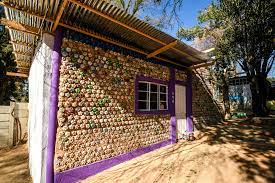By: Aarifah Loonat
For South African citizens, illegal dumping is a familiar topic. For years, it along with littering, has been a problem for the country. During the COVID-19 lockdown, illegal dumping had gotten worse as many essential workers had been unable to remove waste due to pandemic restrictions and catching the virus itself. However, innovative minds have come up with a way to help the issue of illegal dumping while also providing a sustainable means for South Africans to construct buildings through Eco-bricks.
Added to the problem of illegal dumping is the issue of insufficient housing, where a large portion of the population relies on squatter camp settlements. Houses made of tin, and other discarded materials, are occupied by many families, with no plumbing and limited electrical supplies.
This is what eco-bricks attempt to solve.
It is difficult to discern who exactly came up with the idea for Eco-bricks. According to ecobricks.org, the principles of Eco-bricks are inspired by Igorots, the indigenous people of Northern Luzon. Regardless, many South Africans are taking advantage of the idea. Eco-bricks are described as simple, low-tech, non-capital, plastic transition technology that follows the earth’s example of carbon care”.
Sisters Kekeletso and Kedibone Tsiloane have started their factory that turns plastic waste collected from waste pickers into Eco-bricks sold in building material suppliers in Johannesburg. Their PlastiBrick, made from 30% recycled plastic, is fire-retardant and durable, paving a new path for sustainable development in the country. However, more cost-effective solutions are also available to the South African public.
Homemade Eco-bricks are made by filling plastic bottles with non-recyclable waste materials. Preferably, the Eco-brick should be made using two-litre bottles. As writer Tyler Leigh Vivier mentions, making Eco-bricks keeps plastic out of water sources and landfills, thus reducing the amount of waste in dump sites and causing less pollution.
Eco-bricks may be filled with the following materials: plastic straws; plastic wrap; chip packets; the plastic stick from earbuds; old toothbrushes; cellophane; balloons; polystyrene; and plastic cutlery. The ‘bricks’ should weigh more than 500 grams and should be densely packed so that it is strong enough to hold a person’s weight. Additionally, the plastic packed inside must be clean and dry.
Tyler Vivier also provides instructions on how to fill an Eco-brick:
- Identify materials that are not compostable or recyclable by your local recycling facility
- Clean any dirty items by using leftover dishwashing water and leave to dry
- Stuff your clean and dry materials into any size or shape plastic bottle
- Compress it as tightly as you can with a stick – NB; this is very important!
- Keep doing this until you’ve got a bottle that is as hard as a brick – we will be squeezing your eco-brick to make sure it’s properly packed! If we can squeeze it, we can’t accept it.
- Set yourself goals to phase out these items until you don’t need to use the eco-brick anymore!
Eco-bricks can be donated to foundations focused on sustainable development and community upliftment. These bricks are then used to construct buildings and benches such as the house sponsored by Dr Trevor Davies in Joza, an informal settlement in the Eastern Cape, South Africa. In an article for The Grahamstown Project, Graeme Holmes explains the Eco-brick project as “a home of dignity” built for Davies’ employee, Sivuyile Kewuti and his family. Made from 5, 000 Eco-bricks that weighs around 3 tonnes of plastic waste, the Eco-brick house was made through donations by local schools in the Grahamstown area. Additionally, Dr Davies purchased Eco-bricks from community members for R2. 50 ($0, 16) per piece. Not only did this project provide housing for a family, but also assisted in cleaning up the town.
However, as exciting as this idea for eco-friendly construction is for under-developed communities, more effort has to be put into plans for Eco-brick development so that communities can be educated regarding the benefits of Eco-bricks, how to make these bricks, and how to use them. Consider the case of Sivuyile’s house three tonnes of eco-bricks were used. Three tonnes of Eco-bricks are recycled plastic that is no longer littered and dumped illegally or left in dumpsites. In an article by Remade Recycling, it is stated that South Africa does not have the monetary or spatial facilities to build new landfill sites. The existing sites are also filling up rapidly:
Of the 520 million tons of waste generated by South Africans every year, only 13% of it is recycled. It is estimated that South African Landfills take up 450 million cubic meters of space and yet over 70% of the “garbage” in South African landfills can actually be composted or recycled.”
Ecobricks.org mentions that the use of Eco-bricks limits the number of toxins let into the atmosphere from degrading plastics and micro-plastics. Plastic is a material that has been used by large corporations and businesses as a cost-efficient means of furthering global business. However, this increasingly excessive use of plastic has left local communities with issues such as litter and illegal dumping that also negatively affects biospheres. In using Eco-bricks, communities are given an opportunity to recycle waste plastic in a way that is beneficial to local communities. It provides an incentive for area clean-ups by being a possible job opportunity.
As recorded by StatsSA, the third quarter of 2021 saw South Africa’s unemployment rate rise to 34, 9%. The beauty of Eco-bricks, especially the homemade kinds is that projects using Eco-bricks provides work opportunities: not only in the manufacturing of these bricks but also in the construction of units built from Eco-bricks. Based on a document created by Plummer’s Disposal Service, it takes around 26 – 32 people to build a house. In a 2018 article, the Huffington Post mentions that around five and a half million South Africans reside in informal settlements. Consider the possibilities of giving these people the opportunity to participate in building Eco-brick houses for them and their families to live in. Women and children could be taught how to make Eco-bricks, a skill that can stay with them forever. Men (and women if they wanted to) could participate in the construction of these buildings, either learning new skills or utilizing the skills which they already possess. The cherry to top the cake is that five and a half million people who live in informal settlements will have solid, sturdy, insulated structures to live in that are capable of having adequate plumbing and access to electricity. This is an opportunity for the government to solve its over-filled dumpsite problem while teaching new skills to its citizens, while also providing better housing to its citizens. To get local schools and NGOs involved means the cost of creating Eco-bricks would not be too high because Eco-bricks can be donated.

All-in-all, it is safe to say that Eco-bricks are the future of sustainable development. Not only are Eco-bricks a great way to manage litter and pollution, but implementing projects based on Eco-brick constructions would help South Africa minimize wastage and save space in dumpsites. Additionally, Eco-brick houses may be the solution for informal settlements in South Africa. By adopting a new way of creating housing, South Africa would be able to provide job opportunities. As a writer born and raised in South Africa, this article is written with a strong South African focus. However, Eco-bricks are being used globally to combat pollution caused by plastic waste, and therefore can be adopted as a means of sustainable development for all African countries. It is exciting to think of the possibilities that Eco-bricks bring, because as ecobricks.org mentions, “the only limit is our imaginations and the collaboration of your community”.


